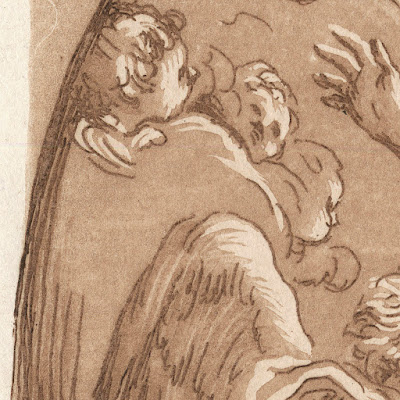Paul Ponce
Antoine Robert de Séri (aka
Paul-Ponce-Antoine Robert) (1686–1733) and Nicolas
Le Sueur (aka Nicolas Lesueur) (1690-1764)
“Assumption of
the Virgin” (aka “L'Assomption de la Ste. Vierge” [as inscribed on plate]), 1729–64,
after the drawing by Giuseppe Passeri (1654–1714),
plate 131 from the series, “Recueil d'estampes d'après les plus beaux tableaux
et d'après les plus beaux desseins qui sont en France” (aka “Recueil Crozat”; “Cabinet
Crozat”), published by Basan in 1764.
Etching with
aquatint in the style of a chiaroscuro woodcut on laid paper (with a watermark)
with the collection stamp of Johann Balthasar Bullinger the Elder (1713–1793) (Lugt 3292). Note that the earlier states of this print (c.1729) show use of
etching with a woodcut plate rather than the later state of the Basan edition (1764)
where etching is employed with an aquatint plate.
Size: (sheet) 42.6
x 28.5 cm; (plate) 29.7 x 23.7 cm; (image borderline) 25.3 x 22.5 cm.
Lettered on
plate below the image borderline: (centre) “L'Assomption de la Ste. Vierge. / D’après
le dessein de Joseph Passari, qui est dans le le Cabinet de Mr Croza[t] / Gravé
à l'eau forte par P. P. A. Robert, et en bois sous sa conduite par Nicolas le
Sueur”; (lower right corner) “131”.
Robert-Dumesnil
1835-71 I.283.12 (Robert-Dumesnil, A P F, “Le Peintre-Graveur Français”, 11
vols.); Le Blanc II.543.10 (Charles Le Blanc 1854–1888, “Manuel de l'amateur
d'estampes: contenant le dictionnaire des graveurs de toutes les nations”, 4
vols., Paris, cat. no. 10, p. 543).
The British
Museum offers the following description of this print from the same state:
“Assumption of
the Virgin, carried into heavens by angels; within oval; after a drawing by
Giuseppe Passeri. c.1729/64 Aquatint imitating a chiaroscuro woodcut, printed
in one shade of brown over etched lines” (https://research.britishmuseum.org/research/collection_online/collection_object_details.aspx?objectId=3170590&page=5&partId=1&peoA=112170-2-23&people=112170&view=list).
See variations in
the colours employed in this print at the Metropolitan Museum of Art (https://www.metmuseum.org/art/collection/search/698371)
and in the earlier state of this print at Harvard Art Museums (https://www.harvardartmuseums.org/collections/object/54405?position=5).
The curator of
the BM offers the following insights into the series known as 'Recueil
Crozat” of which this print is number 79:
“… a series of
plates commissioned by Crozat and reproducing famous paintings and drawings of
the era; 140 plates were published in 1729. A second volume formed by 42 prints
(instead of the 110 plates initially planned) was issued in 1740.
After Crozat's
death, the plates were sold to a company of booksellers who commissioned
Mariette to reorganize the 'Recueil'; Mariette divided the plates into two
volumes, added some missing descriptions, and advertised the set to the public
in 1742.
In 1764, Basan
bought the plates and the text, and republished the 'Recueil', but replaced the
woodcuts by intaglio prints. ... where an attempt to imitate the effect of a
chiaroscuro woodcut is made by using aquatint instead; some of the plates from
this edition bear the signature of F. P. Charpentier, who invented a method
akin to aquatint ... Basan also published the 45 plates reproducing the Italian
paintings from the collection of the Duc d'Orléans in a volume entitled
'Recueil d'après la gallerie du palais royal' (see Heinecken, 'Idée générale
d'une collection d'estampes', Paris 1771, p.76)” (http://www.britishmuseum.org/research/collection_online/collection_object_details.aspx?objectId=1430522&partId=1&museumno=1907%2C1121.14&page=2).
Condition: near
faultless impression with margins. The sheet is in excellent condition for its
age (i.e. there are no tears, holes, losses, abrasions, foxing or significant
stains). There are previous collectors’ notes in ink and pencil verso and a
collector’s ink stamp: “Bullinger” (Lugt 3292)—the stamp most likely belongs to the
Swiss artist and collector, Johann Balthasar Bullinger the Elder (1713–1793);
otherwise it is the stamp of his grandson, Johann Balthasar Bullinger the
Younger (1777–1844).
I am selling
this museum quality, early intaglio print replicating the illusion of a
chiaroscuro woodcut print for the total price of AU$284 (currently US$190.07/EUR173.49/GBP147.38
at the time of posting this listing) including postage and handling to anywhere
in the world.
If you are
interested in purchasing this strong print and a marvellous example of 18th century
technical excellence in the subtle art of trompe l'oeil, please contact me
(oz_jim@printsandprinciples.com) and I will send you a PayPal invoice to make
the payment easy.
This print has been sold
 |
| Collector's stamp verso |











No comments:
Post a Comment
Please let me know your thoughts, advice about inaccuracies (including typos) and additional information that you would like to add to any post.